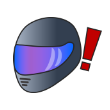In this article, I stopped by to assist a colleague with circuit riding.



I bought a new motorcycle and I want to debut it on a circuit!
But, is a circuit riding inspection different than one for a road riding?

Can I do the pre-ride inspection for a road riding on my own?
Refer to the link below for more information.


Now I can do it on my own.

Let me tell you about the difference between a pre-circuit ride inspection and a normal daily inspection.
1.Inspecting Brakes
The brakes are the most important facet of circuit riding, even when the rider’s
objective is to ride fast!
Brakes not only function to slow the motorcycle to a speed so it can negotiate corners,
they serve to control the attitude of the motorcycle.
For safe, risk-free riding at high-speeds, your brakes always should be inspected.

Brakes are not just for slowing down, right?

I won't go into the details, but the brakes serve many functions: compressing the front forks, changing the caster angle, and controlling loads using rear brakes.

1-1.Checking the brake pad thickness
Check the thickness of the front and rear brake pads.
On public roads, brake pads can be used until worn down to the wear indicator.
For circuit riding, it is preferable for brake pads to be as thick as new ones.
1-2.Check the brake fluid amount and for leakage
Check the amount of fluid in the brake reservoir tank.
Also, check for any brake fluid leakage.
Check for any leakage, particularly from fittings, such as the banjo bolts.
1-3.Checking brake effectiveness
Check that the front and rear brakes are working properly.
For circuit riding, usually you would have the motorcycle stationary on a paddock
stand, and in most cases spin the tires by hand, and apply the brakes to check their
effectiveness.
For a normal daily inspection, check the brakes by pushing the vehicle body forward
while holding the brake lever and depressing the brake pedal.
1-4.Brake lever position adjustment
Check the brake lever position.
Most types of standard motorcycles come with an adjuster on the lever.
Be sure to adjust it to your preferred position.
Brake levers on racing motorcycles often times are designed with an adjustable dial
that can be easily adjusted with your left hand before and while riding.


2.Inspecting Tires
The condition of the tires greatly affects your circuit riding. Be sure you check
the tires before riding.
Weather, temperature, and road surface conditions can also greatly impact the
condition of the tires, so be sure to check the condition the tires after each ride.
2-1.Checking air pressure
Differences in air pressure have a major impact on riding, so be sure to always
check and adjust the air pressure.
Warm and cold tires will have different tire pressures. As a result, the air
pressure is adjusted to the optimal pressure when the tire is cold, while the air
pressure when the tire is hot immediately after riding is recorded.
2-2.Checking the tire condition
Check the tire surface for cracks or foreign objects.
Tires should be checked for rough surfaces and rubber peeling.
On circuits, tires are often times practically worn to the sidewall edge, and after
a ride, tires are often checked before they are covered with tire warmers.
The tires on standard motorcycles, most times wear unevenly on both sides. For this
reason, both sides should be inspected when checking groove depths.

The procedure for checking the tire pressure is slightly different than the one used for daily inspection on public roads, but by and large it is the same. Isn’t it?

Did you notice that? The check points are exactly the same; whether they are for public roads or the track.

3.Inspecting the Engine Area
Points that are checked in a daily inspection for a motorcycle used on public roads, such as checking engine oil level, are also needed for the pre-circuit riding inspection. This section shows the Plus ONE information.
3-1.Checking the amount, color, and odor of engine oil
Check that the engine oil is at the proper level, isn’t strangely colored, and that
it does not smell like gasoline.
During the normal daily inspection, check that the engine oil is at the correct
level.
Engine oil deteriorates over time and should be changed regularly even if the
motorcycle mileage is low.
3-2.Checking the coolant
Check that the coolant is at the proper level.
The coolant in the reserve tank should be at the proper level.
3-3.Engine running condition
Check the condition of the engine while warming up the engine before circuit
riding.
During the standard daily inspection, be sure to check for any abnormalities in
engine acceleration and running.
4.Other Inspections
Typically, headlamps are not required on circuit riding. This section describes
special items that should be checked. The items requiring inspection depend the type
of circuit driving.
Make sure to carry out additional inspections if they are required.
4-1.Checking for looseness
Circuit riding is an environment in which steps and bolts tend to loosen due to extreme vibrations and external forces which are not as prevalent on public roads. For this reason, check for any looseness and rattling prior to riding.
4-2.Inspecting the fuel system for leakage
Check for gasoline leakage as well as oil leakage and coolant leakage.
Fuel hoses are almost never checked in the standard daily inspection, even though
they may deteriorate and cause fuel leaks. Given this, it is a good idea to check
them regularly if you are riding an old motorcycle.
4-3.Fuel quantity
It is surprisingly easy to forget to fuel up. The fuel level should be checked before riding on the circuit or on public roads.
4-4.Inspecting the amount of chain slack
Check the amount of chain slack. Chain slack affects driving characteristics, so it
is a surprisingly important matter to keep the amount of slack how you like it when
circuit riding.
During your normal daily inspection, make sure that the amount of chain slack is
within the specified range.
A less prevalent check is the grip check. Checking the grips is usually not listed
as a normal daily inspection item despite its importance when circuit riding.
Keeping the grips clean and dirt-free will make your riding safe.
Furthermore, we recommend replacing old grips because they gradually wear and the
wear can be difficult to spot. Also, as the rubber wears, gripping power and
vibration absorption decreases.
Replacing grips is surprisingly difficult. Please consult your local Honda dealer.


It looks like even I can inspect these items before riding the circuit!

Basically, the important parts of an inspection are the same, no matter
where you ride.
I will always do my daily inspections!
*Circuit driving may not be covered by the warranty.

Thanks for stopping by today to help with my circuit riding practice.
If you want to ride the circuit, I have some pointers for you too!